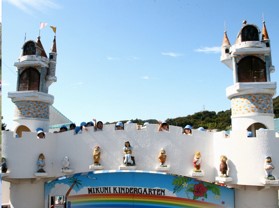
Mikuni Kindergarten, Yokosuka Japan*
To watch a child play is to watch the wonder of discovery. Childhood is essentially a time of experimentation. How high can I climb? How far can I run? What happens if I pull this, press that? It’s joyous and scary and those who know about kid brains say it’s essential to brain development.
Of course, children will find a way to play, even alone in a one-room dirt hut, but should they have to find a way? Before moving to Japan I familiarized myself with the kindergarten curriculum in Virginia (where we lived). Well, what I have read isn’t the curriculum so much as the benchmarks the children are supposed to reach before entering kindergarten (yes, before they even set foot in school) and by the end of the year. I remember thinking, When do they play?
I visited a Japanese preschool today. In fairness, this is a private school that emphasizes physical activity, so it is not representative of the “average” preschool. Still, it’s not known locally as one-of-a-kind, or progressive, or any term that wouldn’t begin to describe it anyway.
Up, up I drove, winding back and forth in my smallish car down very narrow streets I could not believe were two way. I lost every indication of the city; two- and three-story traditional Japanese houses hugged the curves. And then, the car’s surly transmission gave a final lurch to send me to the top of the hill, where I saw a steeple.
The street I crept down at 5kph cut the white cement school in half. On both sides, colorful gates, paintings of kids playing, and the sounds of children. A kind older man helped guide me into a non-existent parking spot. “Arigato gosaimasu,” I said and bowed my head.
As I entered the courtyard (and my child took off toward a 1980’s era giant space shuttle slide) gym class was in full effect. Twenty or so children dressed in loose white tank tops, navy blue cotton shorts, and light blue (or pink or yellow) cotton caps stood in lines stretching their arms toward the sky, then down to their toes, then up, then down.
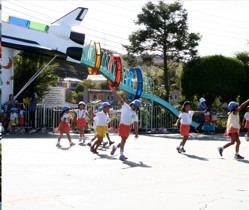
Mikuni Kindergarten Promotional Photo
This wasn’t gym class as we would think of it, my guide explained. Regular rigorous physical activity is essential to a balanced body, so after an hour of free play the children start their formal school day with a “run” up a bamboo trail (she pointed to the hill behind us and my mouth dropped open), during which they get out some morning energy and also discuss safety as they cross several country roads. Then it’s back to the campus – and I use the word campus, but this entire school would fit in one wing of an American elementary school – for morning songs and lessons.
The classes, which range from 2.5yr old to kindergarten, take turns in the courtyard “running” obstacle courses and jumping hurdles that I noticed could be made incrementally higher as the children master each height. A thin Japanese woman with a whistle tells a girl to run and jump the hurdle again, and again (higher), and again (higher), all the time smiling and cheering her on. After the fourth or fifth time she gave the girl a tremendously warm hug before waving the next child forward.
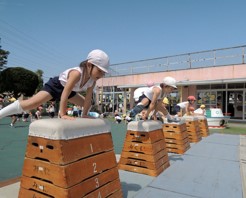
Mikuni Kindergarten Promotional Photo
Don’t let the promo photo fool you, either. This hurdling exercise was not this intense, and the children who were waiting their turn weren’t sitting obediently, either. They were fidgeting with their shorts, talking to their neighbor, plucking some grass, or watching the kid jumping the hurdles. In short, they were just being kids.
The tour continued inside, where I could hear children singing out of tune in “the basement.” I changed out of my Sperry’s and into indoor shoes resembling slippers, embarrassed that I had not worn socks. Japanese people do not wear outdoor shoes indoors. I descended a staircase, passed a brightly colored open bathroom area, and continued to the first classroom. The floor wasn’t really a basement; it was built into part of the hill. Natural light shone through the wall of windows and there was no need for overhead lighting. Also, no air conditioning.
The teacher was transitioning the kids from their previous activity to an art project. She played a Yamaha keyboard, singing a catchy little tune, while all the kids raced to their cubbies and grabbed art supplies. I think the idea was to be back to the tables and seated by the time she was done but, as some things are just universal, there were a handful of little stragglers.
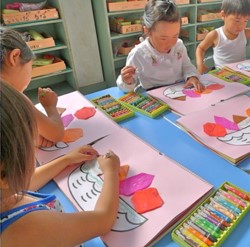
Mikuni Kindergarten Promotional Photo
In the next room a teacher, standing again in front of a keyboard, reviewed colors with the class by holding up swatches as the children yelled, or even screamed the answer. Some were so excited about knowing the answer they shot up out of their little chairs, and that was encouraged.
Back up to the courtyard, another class now navigated through an obstacle course of tires, ropes, wooden boards, and the like, while much younger kids had what Americans would consider traditional recess around the perimeter on the various slides, stairs, and one huge pirate lookout.
My guide led me across the street to the older kindergarten classroom, which is an indoor-outdoor classroom. Imagine a standard room with the back wall completely removed. I don’t know what they do about it in the winter, but it certainly allows for fresh air in the summer. Then it was out to a rolling field with plenty of grass for organized (or disorganized) sports, and four gardens.
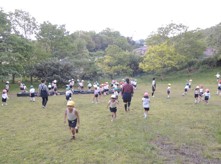
Mikuni Kindergarten Promotional Photo
I asked if part of the curriculum was to teach kids about growing food. The kindergartners, I learned, have a sleepover when the potatoes are ready to harvest. During the sleepover they pull up the potatoes, then peel, cut, and cook them into vegetable curry, which they share together.
Just. Fricking. Wow. Talk about teaching farm to table.
As I thanked the guide and collected our things she handed my child a little paper basket – two construction paper panda faces stapled together with a construction paper handle. “What’s inside?” he said as I tried to keep him from tearing it to shreds. “For later,” she responded and patted him on the head. For the record, “later” was five seconds after I strapped him into the car. It was adorable, delicious, Japanese candy.
Every parent is implored by the very title of “parent” to do what is in his or her child’s best interest. I cannot see how this style of teaching kids is not in a child’s best interest. Every activity stresses physical and mental fitness, fun, and discovery – both internal and external. I have read that Japanese schooling really doesn’t focus on pen-to-paper writing or reading skills until kindergarten at the earliest, although I have not verified whether this is true. But really, what’s the rush? If a child’s mind and body haven’t been developed to receive and process all that knowledge, in short, if a child hasn’t had a well-rounded beginning, what’s the point?
* I did not think it was respectful or appropriate to take pictures while the school was in session. All photos in this post were modified from Mikuni Kindergarten promotional material. If you happen to be looking for a preschool in Yokosuka, or you’re just curious about Mikuni, I highly recommend visiting their website to learn more about their fantastic program. Also, I was not asked or compensated to write this post. I just like the school.
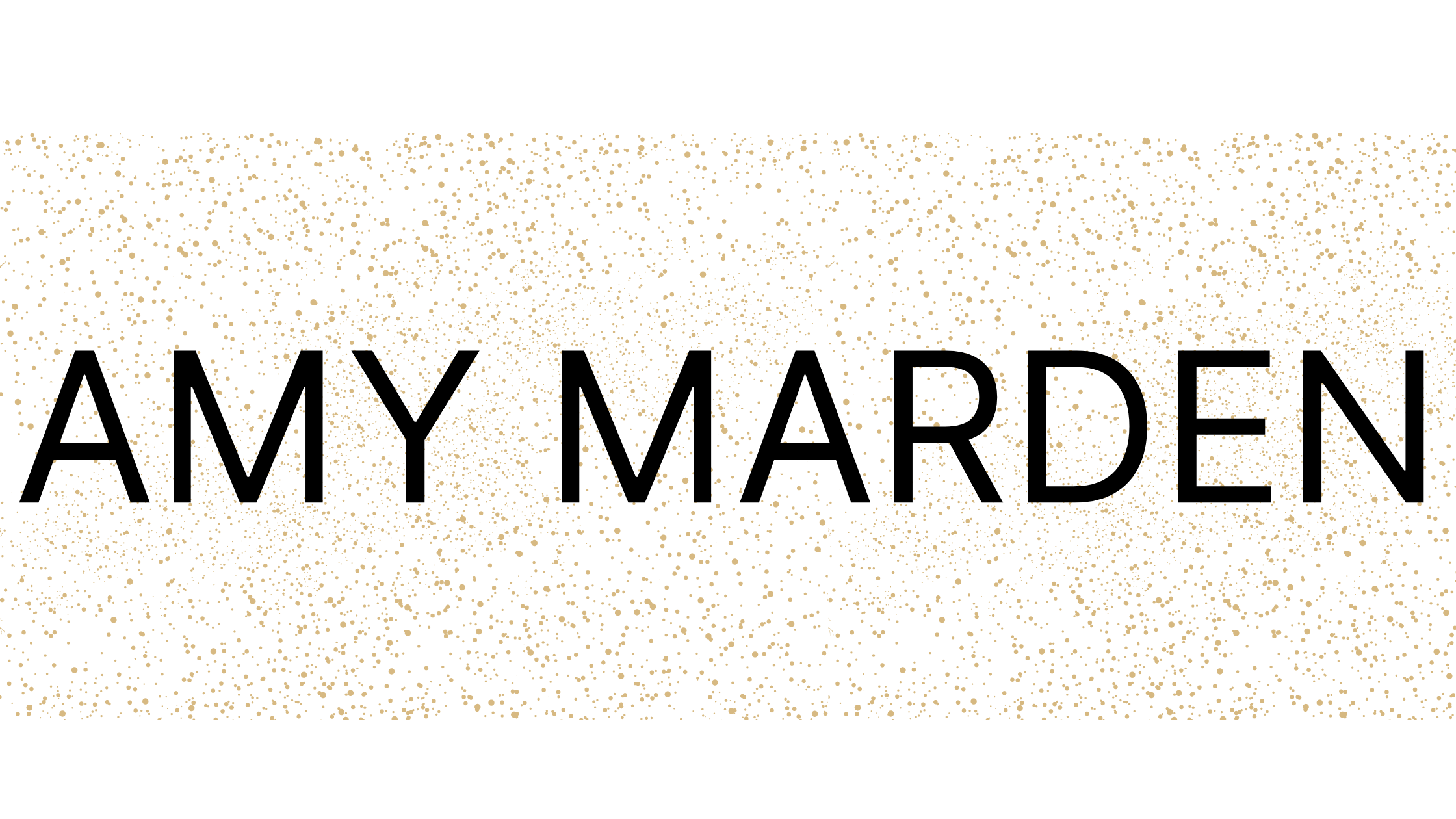
Recent Comments